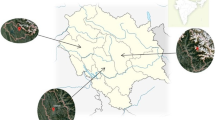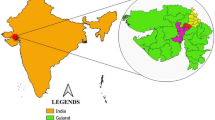Abstract
Analysis of pesticides consisting of 12 organophosphates (OPs), 10 organochlorines (OCs), and 6 pyrethroids in vegetables from Kumasi was conducted. Vegetable samples comprising 20 each of eggplants, okra, and tomatoes were analyzed. The method involves solvent extraction of pesticide residues followed by cleanup using silica gel. Residue analysis was carried out using a GC equipped with pulsed flame photometric detector for OP residues and electron capture detector for OC and pyrethroid residues. The results revealed that methamidophos exceeded the maximum residue limits (MRLs) in all vegetable commodities. Levels of malathion and dimethoate also exceeded the MRLs in eggplant and tomato samples. Endrin, α-endosulfan, γ-hexachlorocyclohexane (HCH), γ-chlordane, and heptachlor exceeded their MRLs in okra samples whereas methoxychlor, allethrin, and deltamethrin exceeded in eggplant samples. Health risk estimation revealed that dimethoate in tomato and endrin, heptachlor, γ-HCH, and γ-chlordane in okra could not pose potential toxicity to the consumer. The combined risk index showed no health risk to consumers due to intake of pyrethroid OC and OP residue on these vegetables. The overall risk index for combined pesticides due to consumption of all the vegetables was higher than 1, which signifies potential health risk to consumers. OPs were the major risk contributor for both eggplant and tomatoes which accounted for 87.78 and 95.84 %, respectively, of the combined risk of pesticides in the vegetables. However, OC with 97.94 % of the combined risk index was the major risk contributor for the okra. The carcinogenic risk of the OCs in okra was of no concern since their carcinogenic rates were below the acceptable risk level.
Similar content being viewed by others
References
Akoto, O., Andoh, A., Darko, G., Eshun, K., & Osei-Fosu, P. (2013). Health risk assessment of pesticides residue in maize and cowpea from Ejura, Ghana. Chemosphere, 92, 67–73.
Al-Eed, M. A., Abo-El-Saad, M., & Al-Faiyz, Y. (2006). Residues and decay of some insecticides in different types of water. Journal of Applied Sciences, 6, 1833–1837.
Agro-Impact Consult (2014). Market for fresh fruits in Accra very high.http://www.myjoyonline.com/business/2014/January-3rd/market-for-fresh-fruits-in-accra-very-high.php#sthash.rllb2SRw.dpuf. Accessed Mar 2014.
Amoah, P., Dreschel, P., Abaidoo, R. C., & Ntow, W. J. (2006). Pesticide and pathogen contamination of vegetables in Ghana’s urban markets. Archives of Environmental Contamination and Toxicology, 50, 1–6.
Baig, S. A., Akhtera, A. N., Ashfaq, M., & Asi, R. M. (2009). Determination of the organophosphorus pesticide in vegetables by high performance liquid chromatography. American-Eurasian Journal of Agricultural and Environmental Sciences, 6(5), 513–519.
Bassil, K. L., Vakil, C., Sanborn, M., Cole, D. C., Kaur, J. S., & Kerr, K. J. (2007). Cancer health effects of pesticides: systematic review. Cancer Family Physician, 53(10), 1704–1711.
Darko, G., & Akoto, O. (2008). Dietary intake of organophosphorus pesticide residues through vegetables from Kumasi, Ghana. Food and Chemical Toxicology, 46, 3705.
Darko, G., & Acquah, S. O. (2008). Levels of organochlorine pesticide residues in dairy products in Kumasi, Ghana. Chemosphere, 71(2), 294–298.
Dinham, B. (2003). Growing vegetables in developing countries for local urban population and export market: problem confronting small scale producers. Pesticides Management Science, 59, 591–596.
Dixon, G. R. (1985). Vegetable crop diseases (p. 404). London: The Macmillan Press Ltd.
Dougherty, C. P., Holtz, S. H., Reinert, J. C., Panyacosit, L., Axelrad, D. A., & Woodruff, T. J. (2000). Dietary exposures to food contaminants across the United States. Environmental Research, 84, 170–185.
EU (2013). Pesticide database, pesticide residues MRLs. www.ec.europa.eu/sanco_pesticides/public/?event=activesubstance.detail. Accessed 20 May 2013.
FAO/WHO (2013). Pesticide residues in food and feed. Acceptable Daily Intake. Codex Alimentarius Commission. FAO/WHO food standard www.codexalimentarius.net/pestres/data/pesticides/details.html. Accessed 15 May 2013.
Gyau, A., & Spiller, A. (2007). The role of organizational culture in modelling buyer seller relationships in the fresh fruit and vegetable trade between Ghana and Europe. African Journal of Business Management, 1(8), 218–229.
Han, B. C., Jeng, W. L., Chen, R. Y., Fang, G. T., Hung, T. C., & Tseng, R. J. (1998). Estimation of target hazard quotients and potential health risks for metals by consumption of seafood in Taiwan. Archives of Environmental Contamination and Toxicology, 35, 711–720.
Horna, D., Smale, M., Al-Hassan, R., Falck-Zepeda, J., & Timpo, S. E. (2008). Selected paper prepared for presentation at the American Agricultural Economics Association Annual Meeting, Orlando, FL.
Iya, I. B., & Kwaghe, T. T. (2007). The economic effect of spray pesticides on cowpea (Vignaunguculata L. Walp.) production in Adamawa state of Nigeria. International Journal of Agricultural Research, 2, 647–665.
Lamptey, J. N. L., Anno-Nyarko, F. O., & Olympio, N. S. (2004). Survey of virus diseases on some major vegetable crops in some ecological zones of Ghana. Ghana Journal of Agriculture, 1, 145–154.
Longnecker, M. P., Rogan, W. J., & Lucier, G. (1997). The human health effects of DDT (dichlorodiphenyltrichloroethane) and PCBs (polychlorinated biphenyls) and an overview of organochlorines in public health. Annual Review of Public Health, 18, 211–244.
Ntow, W. J., Gijzen, H. J., Kalderman, P., & Drechesel, P. (2006). Farmer perceptions and pesticides use practices in vegetable production in Ghana. Pesticide Management Science, 62, 356–365.
Paker, R. (2013). International Training in Pesticide Ecological Risk Assessment. Chemistry International, 35(4), 12–14.
Parker, B. Q., Osei, B. A., Armah, F. A., & Yawson, D. O. (2010). Impact of biomass burning on soil organic carbon and the release of carbon dioxide into the atmosphere in the coastal savannah ecosystem of Ghana. Journal of Renewable Sustainable Energy, 2: 033106-1-033106-7.
Reffstrup, T. K., Larsen, J. C., & Meyer, O. (2010). Risk assessment of mixtures of pesticides. Current approaches and future strategies. Regulatory Toxicology and Pharmacology, 56, 174–192.
Saha, N., & Zaman, M. R. (2012). Evaluation of possible health risks of heavy metals by consumption of foodstuffs available in the central market of Rajshahi City, Bangladesh. Environmental Monitoring and Assessment. doi:10.1007/s10661-012-2835-2.
US EPA. (1986). Guidelines for the health risk assessment of chemical mixtures. Federal Register, 51, 34014–34025.
US EPA (2000). Supplementary guidance for conducting health risk assessment of chemical mixtures. US Environmental Protection Agency. Risk Assessment Forum Technical Panel. Office of EPA/630/R-00/002.
Wang, H. S., Sthiannopkao, S., Du, J., Chen, Z. J., Kim, K. W., Yasin, M. S. M., Hashim, J. H., Wong, K. C., & Wong, M. H. (2011). Daily intake and human risk assessment of organochlorine pesticides (OCPs) based on Cambodian market basket data. Journal of Hazardous Materials, 192, 1441–1449.
Acknowledgments
The authors are grateful to the Pesticide Residue Laboratory of the Ghana Standard Authority, Accra, Ghana, for carrying out the GC analysis for this research work.
Author information
Authors and Affiliations
Corresponding author
Rights and permissions
About this article
Cite this article
Akoto, O., Gavor, S., Appah, M.K. et al. Estimation of human health risk associated with the consumption of pesticide-contaminated vegetables from Kumasi, Ghana. Environ Monit Assess 187, 244 (2015). https://doi.org/10.1007/s10661-015-4471-0
Received:
Accepted:
Published:
DOI: https://doi.org/10.1007/s10661-015-4471-0




